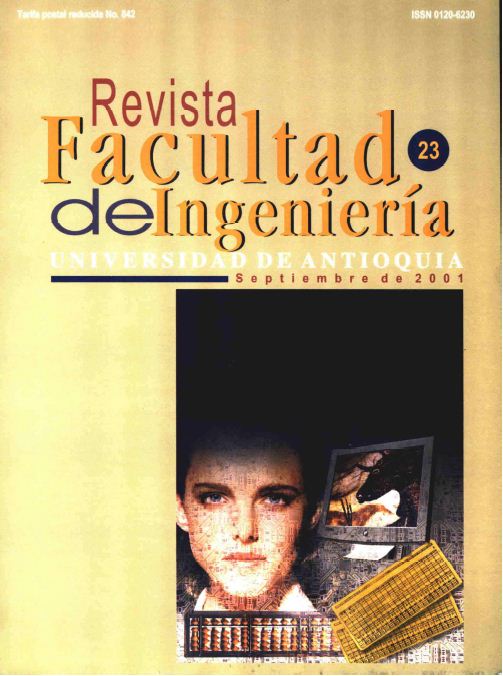Trampas para retención de óxido de azufre
DOI:
https://doi.org/10.17533/udea.redin.326311Palabras clave:
Trampas, desactivación, SO2, NOx, reducción catalítica selectiva.Resumen
Se estudió el comportamiento de varias trampas de azufre, constituidas por los óxidos de cerio, estroncio, bario, cobalto y manganeso, como materiales
adsorbentes de dióxido de azufre (SO2). Se observó que el óxido de cerio presenta la mayor capacidad de adsorción de SO2 y que ésta varía con la cantidad de óxido impregnado. El poder protector del óxido de cerio contra el envenena
miento del catalizador por el SO2 se verificó usando un monolito de cordierita (coming, celcor) recubierto con Co-Mordenita con una o varias capas de 3,25% de CeO2 soportado sobre y-Al2O3 en la reducción catalítica selectiva de NOx
con CH4 como agente reductor en exceso de 02 y en la presencia de 40 ppm SO2 y 10% H2O. Al adicionar 40 ppm SO2 a la mezcla de reacción en presencia de la trampa la conversión de NOx se mantuvo prácticamente constante, mientras que
sin la trampa, disminuyó alrededor de 75%. En presencia de SO2 y H2O el efecto fue más drástico, la actividad fue prácticamente nula sin la trampa y aproximadamente del 12% con la misma. La durabilidad de la trampa se chequeó al realizar cuatro ciclos de adsorción-<lesorción consecutivos sobre el mismo material, encontrándose que después del tercero, el material presentó una buena capacidad de adsorción de SO2.
Descargas
Citas
Iwamoto, M. et al. "lnfluence of sulfur dioxide on catalytic removal of ni trie oxide over copper ion exchange ZSM-5 zeolite". En: Applied Catalysis. Vol. 69. Amsterdam 1991. p. L15. DOI: https://doi.org/10.1016/S0166-9834(00)83286-8
_____ . et al. "Performance and durability of Pt-MFI zeolite castalyst for selective reduction of nitrogen monoxide in actual diesel engine exhaust". En: Applied Catalysis B: environmental. Vol. 5. Amsterdam. 1994. p. L31. DOI: https://doi.org/10.1016/0926-3373(94)00047-6
Li, Y. et al. "Catalytic reduction of nitrogen oxides with methane in the presence of excess oxygen". En: Applied Catalysis B: environmental. Vol. 1. Amsterdam. 1992. p. L31. DOI: https://doi.org/10.1016/0926-3373(92)80050-A
Obuchi, A. et al. "Performance of platinum group metal catalysts for the selective reduction of nitrogen oxide by hydrocarbons". En: Applied Catalysis B: environmemal. Vol. 2. Amsterdam. 1993. p. 71. DOI: https://doi.org/10.1016/0926-3373(93)80027-B
Kim, M. N. et al. "Characteristics of mordenite type zeolite catalysts deactivated by SO2 for the reduction of NO with hydrocarbons". En: Journal of Catalysis. Vol. 179. New York. 1998. p. 350. DOI: https://doi.org/10.1006/jcat.1998.2230
Li, Z. et al. "Effects ofwater vapor and sulfur dioxide on the performance ofCe-Ag-ZSMS for the SCR of NO with CH4". En: Applied Catalysis B: environmental. Vol. 22. Amsterdam. 1999. p. 35. DOI: https://doi.org/10.1016/S0926-3373(99)00036-3
Rao, S. N. R. et al. "Selective sulfur dioxide adsorbents prepared for designed dispersion of group IA and IIA metal oxides on alumina". En: Journal of Catalysis. NewYork. Vol. 163. 1996. p. 176. DOI: https://doi.org/10.1006/jcat.1996.0317
Feeley, J. et al. "Method for using a regenerable catalyzed trap". En: US Patent. Number 5792436. August. 1998.
Hallen, F. et al. "Reusable SOx traps: materials and methods for regeneration". En: Extended abstracts on second world congress 0n environmental catalysis. AICHE. Miami. November. 1998. p. 84.
Bedford, R. et al. "ethod of making a support containing an alumina-ceria washcoat for a noble metal catalyst". En: US patent. Number 5081095. January. 1992.
Masuda, K. et al. "Activity enhancement of Ag/Mordenite catalysts by addition of palladium for the removal ofnitrogen oxides from diesel engine exhaust gas". En: Applied Catalysis B: environmental. Vol.15. Amsterdam. 1998. p. 29. DOI: https://doi.org/10.1016/S0926-3373(97)00034-9
Skoglundn, M. et al. "cobalt-promoted palladium as a three-way-catalyst". En: Applied Catalysis B: environmental. Vol. 7. Amsterdam. 1996. p. 299. DOI: https://doi.org/10.1016/0926-3373(95)00049-6
Farrauto, R. Fundamentals on industrial catalytic processes. London. Blackie Academic and Professional. 1997. p. 106.
Cano, N. et al. Protección de la desactivación de catalizadores en la reducción catalítica selectiva de NOx en presencia de SOx. Tesis de grado. Universidad de Antioquia Medellin. 2000.
Descargas
Publicado
Cómo citar
Número
Sección
Licencia
Los artículos disponibles en la Revista Facultad de Ingeniería, Universidad de Antioquia están bajo la licencia Creative Commons Attribution BY-NC-SA 4.0.
Eres libre de:
Compartir — copiar y redistribuir el material en cualquier medio o formato
Adaptar : remezclar, transformar y construir sobre el material.
Bajo los siguientes términos:
Reconocimiento : debe otorgar el crédito correspondiente , proporcionar un enlace a la licencia e indicar si se realizaron cambios . Puede hacerlo de cualquier manera razonable, pero no de ninguna manera que sugiera que el licenciante lo respalda a usted o su uso.
No comercial : no puede utilizar el material con fines comerciales .
Compartir igual : si remezcla, transforma o construye a partir del material, debe distribuir sus contribuciones bajo la misma licencia que el original.
El material publicado por la revista puede ser distribuido, copiado y exhibido por terceros si se dan los respectivos créditos a la revista, sin ningún costo. No se puede obtener ningún beneficio comercial y las obras derivadas tienen que estar bajo los mismos términos de licencia que el trabajo original.










 Twitter
Twitter